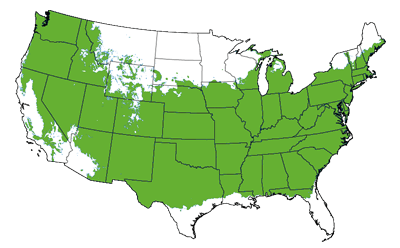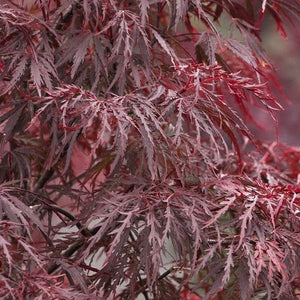Red Dragon Japanese Maple
Product Details
 Growing Zones 5-8
Growing Zones 5-8
| Soil Type | Adaptable, Well Drained |
| Sunlight | Full, Partial |
| Drought Tolerance | Semi |
| Mature Height | 6-10 Feet |
| Mature Width | 6-10 Feet |
| Growth Rate | slow |
| Fall Color | Red |
| Shipping Restriction | AK, AZ, HI |
The Red Dragon Japanese Maple is a stunning dwarf maple with lacy, red foliage. Throughout the year, the delicate leaves change from shades of purple and red, culminating in a superb cherry red in autumn. An upright form with weeping branches, the habit of the Red Dragon Japanese Maple is uniquely beautiful.
The Red Dragon is one of the few varieties of Japanese Maple that grow well in full sun. This adaptable tree is easy to grow and maintain. There is no need to prune this tree. Japanese Maples should be treasured for their natural, unique, and beautiful growth.
Key Features
- Lace Leaf Japanese Maple. The lacy leaves of the Red Dragon have a delicate look and add great texture contrast to the landscape.
- Sun to Shade. The Red Dragon Japanese Maple stands up to full sun better than other dissectum Japanese Maples. It grows well in part shade or part sun locations as well.
- Dwarf tree. The mature size of this tree is about 8 feet tall and wide so it can fit in even the smallest yard.
- Great for containers. This dwarf tree’s petite size makes it perfect for pots and planters!
- Low maintenance. The Red Dragon Japanese Maple is easy to grow. This hardy tree just needs some water when it’s hot and a little food when it’s hungry and it will perform well for years to come.
Pro Tip: Japanese Maples prefer a moist soil. Water them well for the first few months during establishment. Watering deeply once weekly in summer throughout the life of your tree will go a long way toward the health and growth of your tree. Japanese Maples grown in containers need to be watered more often than trees planted in the ground.
Whether it is your first Japanese Maple or just the latest addition to your collection, the Red Dragon Japanese Maple is an excellent choice!
For additional Japanese Maple options be sure to check out our Bloodgood Japanese Maple and our Japanese Maple Collection
How To Plant A Red Dragon Japanese Maple?
Dig a hole 3 times as wide as the rootball and plant this tree in the fall giving it atleast a month for roots to settle before the winter frost. Place your tree into the hole with the top of the roots sitting slightly above the surface and backfill the dirt mixed with slow release fertilizer.
Where Should I Plant This Japanese Maple?
This maple is adaptable to a variety of well drained soil. Pick a spot that gets full sun to part shade exposure in grow zones 5-8. A great tree to add to your meditation garden or mixed bed.
What Are Good Comapnion Plants For This Tree?
Azaleas, ferns, and hostas are amongst the top choices for companion plants with a Red Dragon.
When planting your Red Dragon Japanese Maple make sure you have the right location and conditions for your new tree to thrive. Spring and fall are ideal times to plant. However, if you avoid freezing and hot temperatures you can plant your maple almost any time of the year.
The Red Dragon is much more sun tolerant than other Japanese Maples. It can grow in full sun to part shade. Japanese Maples prefer soil that is well-draining, but moist, neutral to slightly acidic, and nutrient rich. However, they will adapt to a variety of soils. Mulching will keep the roots moist and protect them from extreme temperatures. Add a layer of about 2 inches of mulch. Do not allow the mulch to touch the trunk as this increases the chances of pests and disease. Japanese Maples should be watered often enough to keep the soil moist. Do not allow the soil to dry completely or be overly saturated. Either condition can harm a these trees. Fertilize in early spring and when planting to give your tree a boost. Choose a slow release fertilizer. Lace Leaf Maples don't generally require pruning, but, if needed, prune when they are dormant to remove any dead, dying, or crowded branches, or to maintain shape.
The best way to prevent disease and pests is by providing the appropriate care for your plants. Proper location choice, watering, and fertilization are the keys to your success. Scale, Mites, and Aphids are insects that can occasionally affect Japanese Maples. You can treat these pests naturally with horticultural oil, neem oil, or insecticidal soap. For severe infections you can use pesticides like carbaryl, also known as Sevin. Another potential pest is the Japanese Beetle. Look into parasitic nematodes and bacillus thuringiensis for effective organic control of this pest.













